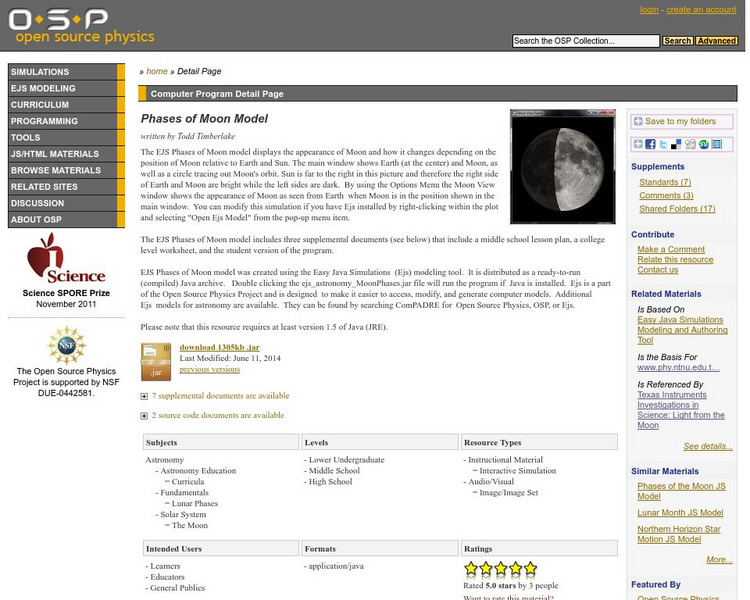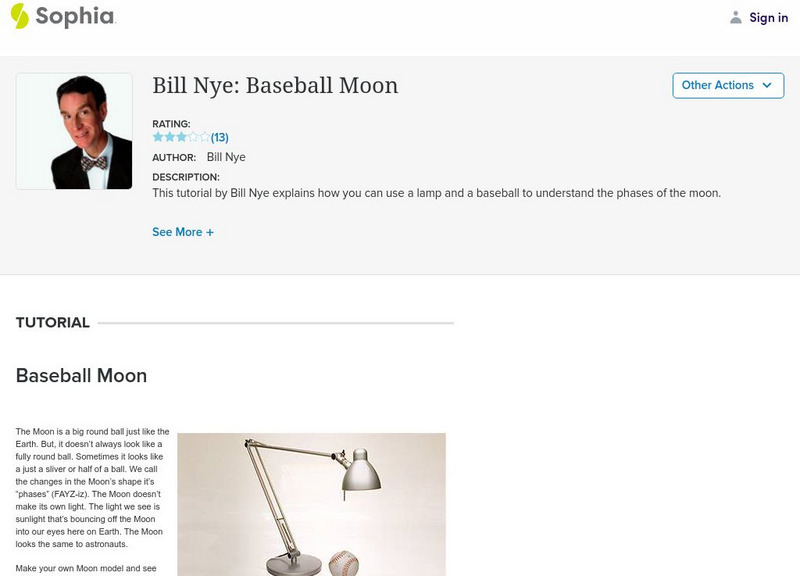Hi, what do you want to do?
Curated OER
Investigation 3 - What is Moonlight?
Third graders observe a demonstration explaining that the moon reflects sunlight in ordr to shine.
Curated OER
Energy Defined
Fourth graders complete activities to study the sources of energy and forms. In this energy instructional activity, 4th graders discuss the origin of energy and define it. Students participate in several experiments to further study...
Curated OER
Retrograde Motion
Students study the motions of the heavenly bodies. In this space lesson plan students use models to show a variety of schemes explaining the motions.
Curated OER
Weather Report
Students prepare a weather script for a broadcast. In this weather broadcasting instructional activity, student record the present temperature, high temperature, a sky watch, and the current moon phase to be presented in a school...
Curated OER
Our Sky Clock
Students explore space science by completing a worksheet in class. In this astronomy lesson, students discuss and identify star patterns in the night sky and relate these patterns to the approximate time they appear. Students complete an...
Curated OER
How Do Weather Conditions and Lunar Cycles Affect Fishing Success?
Students use weather measuring devices to record and study weather conditions at different locations, during different times. They attempt to draw conclusions about the relationship between weather conditions, lunar cycle and fishing...
Curated OER
Charting Seasonal Changes
Students research the Earth's patterns of rotation and revolution, create a chart and graph of these patterns and use them to explain the causes of night and day and summer and winter.
Curated OER
Cnidarians
In this cnidarians worksheet, students will read 4 descriptions and identify each as either the polyp or medusa form of cnidarian. Then students will complete 3 short answer questions about the characteristics of cnidarians. Finally,...
Curated OER
Eclipses
In this eclipses worksheet, students read about solar and lunar eclipses to complete 8 short answer questions comparing the two types of eclipses.
Curated OER
Vietnam Trade Pact
Young scholars explore world trade issues. In this economics lesson, students read "Opening Doors to Vietnam," and discuss the trade negotiations between Vietnam and the Untied States. Young scholars conduct further research on the topic...
Curated OER
Arranging the Elements
Students describe how elements are arranged in the periodic table. They compare metals, nonmetals, and metalloids based on their properties and on their location in the periodic table. Finally, students identify and describe the...
Curated OER
Solar and Lunar Eclipses
Students examine eclipses. In this eclipse lesson, students investigate solar and lunar eclipses. Students complete a WebQuest and write a descriptive summary of eclipses. Lesson references a WebQuest, but does not include a link.
Curated OER
Galileo Galilei Questions for Study
In this online interactive philosophy worksheet, students respond to 10 short answer and essay questions about Galileo's contributions to science.
Curated OER
Collecting Electromagnetic Radiation
Students using different experiments and activities explore electromagnetic radiation and the effect on the Earth.
Curated OER
Celestial Photography
Students practice photographic skills and gain an awareness of photography as a scientific tool.
Curated OER
Pattern Detectives
Students discover patterns in language, math and science. They experience patterns by hearing stories, and becoming pattern detectives.
Curated OER
Taking Risks: Drug and Alcohol Abuse
Students discuss a video about drug and alcohol abuse and their connection to risk-taking. They answer questions on a risk factor sheet about the use of tobacco, drugs, and alcohol. They discuss long and short term goals and how not...
ArtsNow
Arts Now Learning: Phases of the Moon [Pdf]
In this lesson, 4th graders use their bodies to model the day/night cycles of the Sun and Earth. Next, they discuss the moon's role in the solar system and explore the eight phases of the moon by acting out a story. Finally, a song...
Ducksters
Ducksters: Kids Science: Phases of the Moon
Kids learn about the science of the phases of the moon. Full, Gibbous, Quarter, and Crescent.
Science Buddies
Science Buddies: Measuring the Moon
Sometimes a full moon can be so bright, you can walk around in the dark without a flashlight. How much brighter is a full moon than the other phases of the moon? How is the brightness of the moon measured?
Science Buddies
Science Buddies: The Moon and the Stars
When you are in the city, only a few of the brightest stars are visible. But when you are in the country, you can see many more stars than you can count. Sometimes you can even see the bright belt of our galaxy, the Milky Way. In this...
American Association of Physics Teachers
Com Padre Digital Library: Open Source Physics: Phases of the Moon Model
Examine the changes that occur with the moon's movement in relationship to the Earth and Sun with this astronomy simulation.
Sophia Learning
Sophia: Bill Nye: Baseball Moon
Bill Nye explains the phases of the moon with an experiment using a baseball, a lamp on a table, a dark room, and a stool or chair that swivels. As the person moves around, the changes in reflected light show the phases of the moon. The...























![Arts Now Learning: Phases of the Moon [Pdf] Lesson Plan Arts Now Learning: Phases of the Moon [Pdf] Lesson Plan](https://static.lp.lexp.cloud/images/attachment_defaults/resource/large/FPO-knovation.png)




